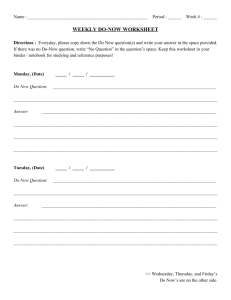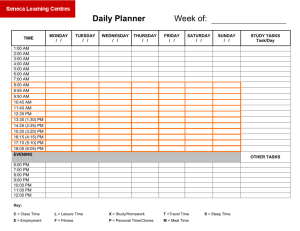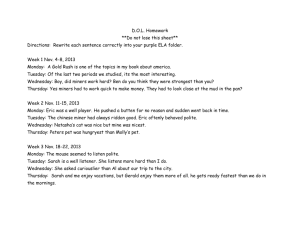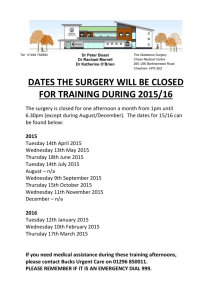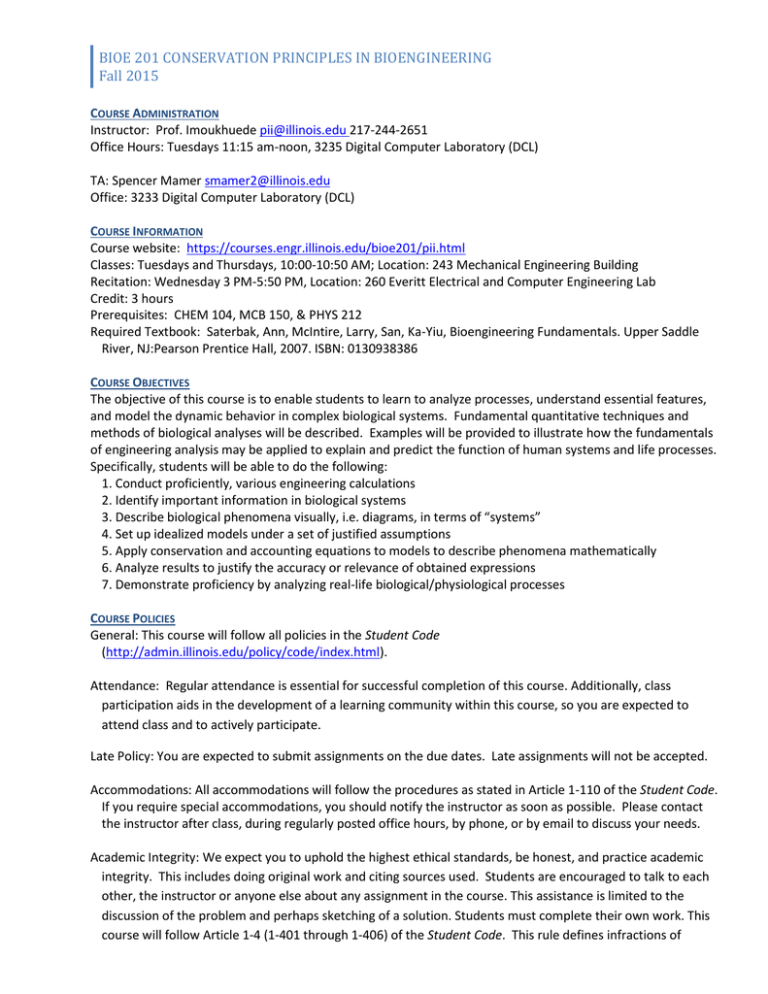
BIOE 201 CONSERVATION PRINCIPLES IN BIOENGINEERING
Fall 2015
COURSE ADMINISTRATION
Instructor: Prof. Imoukhuede pii@illinois.edu 217-244-2651
Office Hours: Tuesdays 11:15 am-noon, 3235 Digital Computer Laboratory (DCL)
TA: Spencer Mamer smamer2@illinois.edu
Office: 3233 Digital Computer Laboratory (DCL)
COURSE INFORMATION
Course website: https://courses.engr.illinois.edu/bioe201/pii.html
Classes: Tuesdays and Thursdays, 10:00-10:50 AM; Location: 243 Mechanical Engineering Building
Recitation: Wednesday 3 PM-5:50 PM, Location: 260 Everitt Electrical and Computer Engineering Lab
Credit: 3 hours
Prerequisites: CHEM 104, MCB 150, & PHYS 212
Required Textbook: Saterbak, Ann, McIntire, Larry, San, Ka-Yiu, Bioengineering Fundamentals. Upper Saddle
River, NJ:Pearson Prentice Hall, 2007. ISBN: 0130938386
COURSE OBJECTIVES
The objective of this course is to enable students to learn to analyze processes, understand essential features,
and model the dynamic behavior in complex biological systems. Fundamental quantitative techniques and
methods of biological analyses will be described. Examples will be provided to illustrate how the fundamentals
of engineering analysis may be applied to explain and predict the function of human systems and life processes.
Specifically, students will be able to do the following:
1. Conduct proficiently, various engineering calculations
2. Identify important information in biological systems
3. Describe biological phenomena visually, i.e. diagrams, in terms of “systems”
4. Set up idealized models under a set of justified assumptions
5. Apply conservation and accounting equations to models to describe phenomena mathematically
6. Analyze results to justify the accuracy or relevance of obtained expressions
7. Demonstrate proficiency by analyzing real-life biological/physiological processes
COURSE POLICIES
General: This course will follow all policies in the Student Code
(http://admin.illinois.edu/policy/code/index.html).
Attendance: Regular attendance is essential for successful completion of this course. Additionally, class
participation aids in the development of a learning community within this course, so you are expected to
attend class and to actively participate.
Late Policy: You are expected to submit assignments on the due dates. Late assignments will not be accepted.
Accommodations: All accommodations will follow the procedures as stated in Article 1-110 of the Student Code.
If you require special accommodations, you should notify the instructor as soon as possible. Please contact
the instructor after class, during regularly posted office hours, by phone, or by email to discuss your needs.
Academic Integrity: We expect you to uphold the highest ethical standards, be honest, and practice academic
integrity. This includes doing original work and citing sources used. Students are encouraged to talk to each
other, the instructor or anyone else about any assignment in the course. This assistance is limited to the
discussion of the problem and perhaps sketching of a solution. Students must complete their own work. This
course will follow Article 1-4 (1-401 through 1-406) of the Student Code. This rule defines infractions of
academic integrity, which include but are not limited to cheating, fabrication, and plagiarism. You are
responsible for following these guidelines. If you have any questions about whether something would be an
infraction, please review both the College of Engineering and Bioengineering webpages on academic integrity
(listed below) and consult with the instructor before proceeding.
College of Engineering: https://wiki.engr.illinois.edu/display/ugadvise/Academic+Integrity++A+Guide+for+Engineering+Students
Bioengineering: http://bioengineering.illinois.edu/undergraduate-programs/advising/academicmisconduct-faq
Appreciation for and Utilization of Diversity: We value the diversity represented by the participants in this
course. Our diversity is a primary source of ideas and perspectives, and you will work in cohorts to practice
the use of that diversity. We expect that students will work together to assume a variety of roles effectively
drawing on each other’s skills, interests, and strengths, and interacting in a collaborative and collegial manner.
GRADING
Your grade will be determined by the total points earned from the following:
Homework
200 points
Quizzes/Participation
100 points
Exam #1
150 points
Exam #2
150 points
Exam #3
150 points
Project #1
100 points
Project #2
50 points
Final Project
100 points
Total points
1000 points
Scale: 100-97% A+, >97-93% A, >93-90% A-, >90-87% B+, >87-83% B, >83-80% B-, >80-77% C+, >77-73% C, >73-70% C-,
>70-67% D+, >67-63% D, >63-60% D-, >60-0% F
Homework: Homework is due on the date indicated on the assignment. Late homework will not be accepted.
Homework in the course will comprise engineering problems, project progress reports, and team building
exercises; each of these will contribute to your final grade.
Quizzes: In class quizzes will be assigned throughout the semester either individually or to student groups. A
missed quiz cannot be made up for credit.
Exams: There will be three exams administered during the semester. An unexcused absence will result in a zero
for that exam. Exams can only be made up due to a verifiable emergency or illness. The make-up exam must
be taken not later than two days after the regularly scheduled unit exam. Cell phone use will not be permitted
during examinations. Students may not leave the room during examinations.
Projects: Projects and presentations will be assigned during the semester. No extensions will be granted for
projects.
Conservation of Energy & Team Building
Conservation of Mass
Modules
Week
1
2
3
4
5
6
7
8
9
Statics and Dynamics
10
11
12
13
Synthesis
14
14
15
Date
Tuesday, Aug. 25
Wednesday, Aug. 26
Thursday, Aug. 27
Tuesday, Sept. 1
Wednesday, Sept. 2
Thursday, Sept. 3
Tuesday, Sept. 8
Wednesday, Sept. 9
Thursday, Sept. 10
Tuesday, Sept. 15
Wednesday, Sept. 16
Thursday, Sept. 17
Tuesday, Sept. 22
Wednesday, Sept. 23
Thursday, Sept. 24
Tuesday, Sept. 29
Wednesday, Sept. 30
Thursday, Oct. 1
Tuesday, Oct. 6
Wednesday, Oct. 7
Thursday, Oct. 8
Tuesday, Oct. 13
Wednesday, Oct. 14
Thursday, Oct. 15
Tuesday, Oct. 20
Wednesday, Oct. 21
Thursday, Oct. 22
Tuesday, Oct. 27
Wednesday, Oct. 28
Thursday, Oct. 29
Tuesday, Nov. 3
Wednesday, Nov. 4
Thursday, Nov. 5
Tuesday, Nov. 10
Wednesday, Nov. 11
Thursday, Nov. 12
Tuesday, Nov. 17
Wednesday, Nov. 18
Thursday, Nov. 19
Tuesday, Nov. 24
Wednesday, Nov. 25
Thursday, Nov. 26
Tuesday, Dec. 1
Wednesday, Dec. 2
Thursday, Dec. 3
Tuesday, Dec. 9
Wednesday, Dec. 9
Friday, Dec. 11
Topic
Introduction to Engineering Calculations (1.1-1.5)
Introduction to Engineering Calculations (1.5-1.8)
Foundations of Conservation Principles (2.1-2.6)
Conservation of Mass (3.1-3.3)
Conservation of Mass (3.3-3.5)
Conservation of Mass (3.6 & 3.7)
Conservation of Mass (3.8)
Conservation of Mass (3.8 & 3.9)
Conservation of Mass (3.9)
Review: Conservation of Mass
Review: Conservation of Mass
Exam #1 (Location TBA)
Project #1 Introduction
Conservation of Energy (4.1-4.2)
No Class (due to 2 hr exam on 09/17)
Conservation of Energy (4.3-4.4)
Conservation of Energy (4.5-4.7)
Conservation of Energy (4.8)
Conservation of Energy (4.9-4.10)
Project #1 Presentations
DISC Seminar
Conservation of Energy Problems
Conservation of Energy Problems
Conservation of Energy Problems
Review: Conservation of Energy
Project #2 Introduction + Simbiology Tutorial
Biomechanics & Rigid Body Statics (6.1-6.2)
Biomechanics & Rigid Body Statics (6.3-6.5)
Exam #2
Biomechanics & Rigid Body Statics (6.3-6.5)
Fluid Statics & Dynamics (6.6-6.8)
Project #1 Poster Session
Fluid Statics & Dynamics (6.8-6.11)
Review: Statics & Dynamics
Review: Statics & Dynamics
Exam #3 (Location TBA)
Project #2 Presentations
Project #2 Presentations
No Class (due to 2 hr exam on 11/12)
Thanksgiving Vacation (NO LECTURE)
Thanksgiving Vacation (NO LECTURE)
Thanksgiving Vacation (NO LECTURE)
Project Meetings
Project Meetings
Project Meetings
Final Project Presentations
Final Project Presentations
Final Projects Due
General Emergency Response Recommendations
These recommendations are provided by the Office of Campus Emergency Planning. There are two basic
methods to respond in emergencies that may affect persons on campus, and more specifically, individual
buildings: Building Evacuation (GET OUT) and Shelter-In-Place (STAY IN).
ONLY FOLLOW THESE ACTIONS IF SAFE TO DO SO. When in doubt, follow your instincts - you are your best advocate!
Building Evacuation (GET OUT) — Action taken to leave an area for personal safety.
Take the time to learn the different ways to leave your building BEFORE there is an emergency.
Evacuations are mandatory for fire alarms and when directed by authorities! No exceptions!
Evacuate immediately. Pull manual fire alarm to prompt a response for others to evacuate.
Take critical personal items only (keys, purse, and outerwear) and close doors behind you.
Assist those who need help, but carefully consider whether you may put yourself at risk.
Look for EXIT signs indicating potential egress/escape routes.
If you are not able to evacuate, go to an Area of Rescue Assistance, as indicated on the front page of this
plan.
Evacuate to Evacuation Assembly Area, as indicated on front page of this plan.
Remain at Evacuation Assembly Area until additional instructions are given.
Alert authorities to those who may need assistance.
Do not re-enter building until informed by emergency response personnel that it is safe to return.
Shelter-in-Place (STAY IN) — Action taken to seek immediate shelter indoors when emergency conditions do not
warrant or allow evacuation.
Severe Weather
o If you are outside, proceed to the nearest protective building.
o If sheltering-in-place due to severe weather, proceed to the identified Storm Refuge Area or to
the lowest, most interior area of the building away from windows or hazardous equipment or
materials.
Security Threat
o If you cannot safely evacuate, find a secure area within your building to stay and await further
information.
o Assist those who need help, but carefully consider whether you may put yourself at risk.
o Once within a safe place, attempt to secure the space (i.e.: lock doors, close windows/blinds).
o If unable to lock the door, secure it by any means possible.
o Remain quiet, unless making noise would be beneficial to your safety (i.e.: rescue recovery).
o Without jeopardizing your safety, try to obtain additional clarifying information by all possible
means, including the Illini-Alert Emergency Text Notification System.

